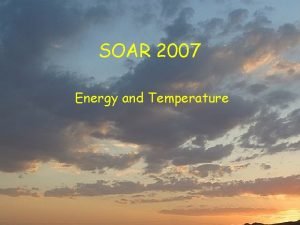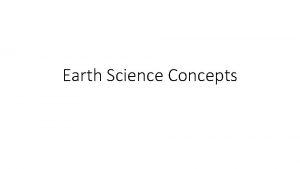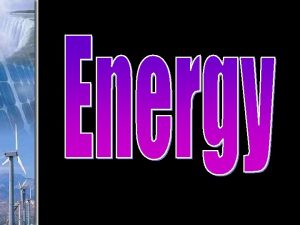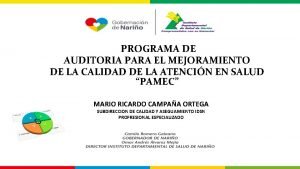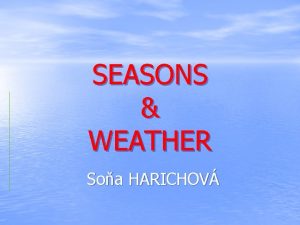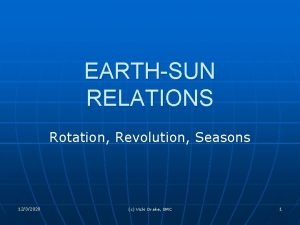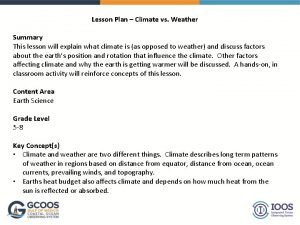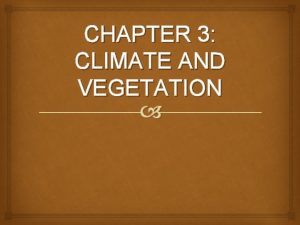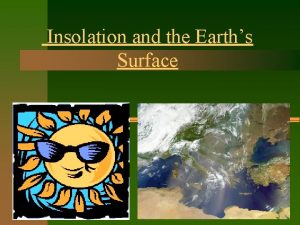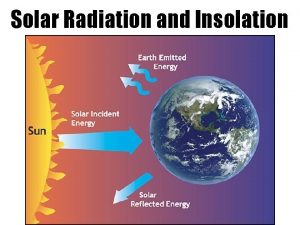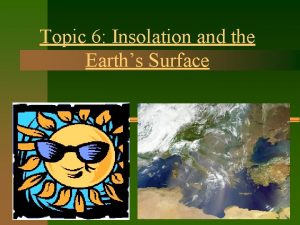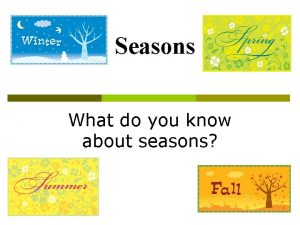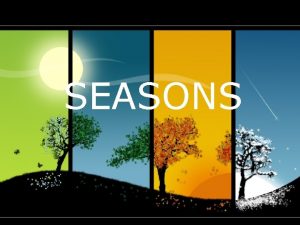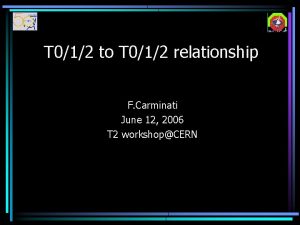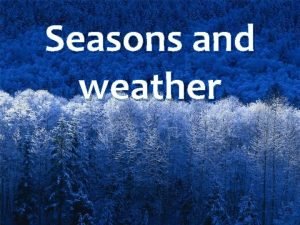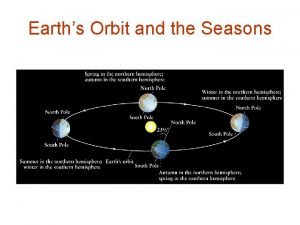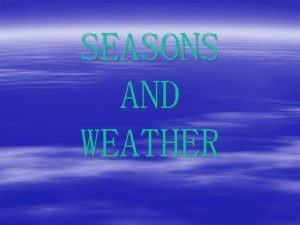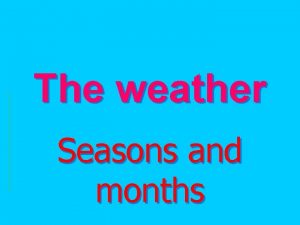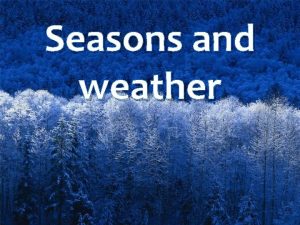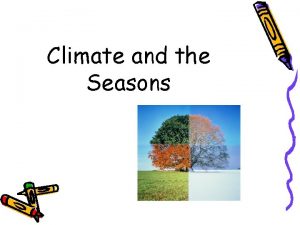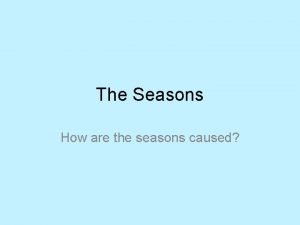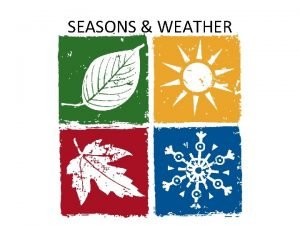Insolation and the Seasons 012 10989 r 1








































- Slides: 40

Insolation and the Seasons 012 -10989 r 1. 04

Insolation and the Seasons 012 -10752 r 1. 04

Insolation and the Seasons Introduction Journals and Snapshots The Snapshot button is used to capture the screen. The Journal is where snapshots are stored and viewed. The Share button is used to export or print your journal to turn in your work. Each page of this lab that contains the symbol should be inserted into your journal. After completing a lab page with the snapshot symbol, tap (in the upper right hand corner) to insert the page into your journal. Note: You may want to take a snapshot of the first page of this lab as a cover page for your journal.

Insolation and the Seasons Lab Challenges How does the Earth's tilt relative to the Sun relate to climate and the seasons? What is the impact of changes in the angle of solar insolation on solar energy delivered to a given area? Consider the impact of variations in insolation angles on solar energy technologies. Solar radiation map of the U. S.

Insolation and the Seasons Background • Solar energy coming from the sun is by far the most important factor influencing weather and climate on planet Earth. • Daily and seasonal variation in the amount of incoming sunlight drives the winds, stirs the ocean currents, and heats the land. • The solar energy that Earth receives is called insolation.

Insolation and Self-Check Self Check the Seasons 1. Insolation is the __________. a) amount of sunlight reflecting off snow and other white materials. b) total energy coming from the sun. c) total energy inside the sun. d) material stuffed into sleeping bags. e) difference in temperature between summer and winter.

Insolation and the Seasons Background • The Earth spins daily around its axis of rotation, which is tilted approximately 23. 5 degrees relative to its orbit around the Sun. • No matter the time of year, one part of the planet is always exposed to more direct insolation than the other. • As the Earth orbits the Sun, the amount of insolation will change at any particular location, thus causing the seasons to change. Sun rays at the equator hit a smaller surface area, so they are more concentrated. Sun rays near the poles spread out along the curve of the Earth, so they are less concentrated.

Insolation and the Seasons Background • During half of the Earth's orbit around the sun the northern hemisphere is angled closer to the sun, and experiences summer weather. During the other half of the year the southern hemisphere is angled closer to the sun, so it experiences summer weather. • Weather differences between hemispheres are, to a much lesser degree, caused by the elliptical orbit of Earth reaches perihelion (closest to the Sun) in January and reaches aphelion (farthest from the Sun) in July. This slightly softens the northern hemisphere's winters and summers. In the southern hemisphere, the opposite effect is observed.

Insolation and the Seasons Self-Check 2. The most important factor contributing to seasons on Earth is _________. a) amount of greenhouse gases. b) distance of sun from Earth. c) desire to go holiday shopping. d) angle of sunlight relative to Earth. e) rockiness of the landscape.

Insolation and the Seasons Safety • Follow all standard laboratory safety procedures. • Do not look directly at the Sun. It can permanently damage the retinas inside your eyes.

Insolation and the Seasons Materials and Equipment Collect all of these materials before beginning the lab. • Fast response temperature sensor • Cardboard, 15 x 15 cm • Small tripod stand with rod • Black construction paper • 3 -fingered clamp • Drinking straw • Protractor • Tape • Scissors • Glue

Insolation and the Seasons Sequencing Challenge A. Put the 60° solar panel in the sun for 5 minutes, then measure its temperature. Cool it off, then repeat the experiment with the panel set at 30°. C. Construct a solar panel that absorbs light energy and lets you quantitatively change its angle in relation to a light source and measure the surface temperature. B. Set up the solar panel perpendicular (90°) to the sun's incoming rays. Measure the temperature after 5 minutes. E. Shade the solar panel and let it cool. Readjust the solar panel to a 60° angle. D. Repeat the data collection step. Compare the maximum temps achieved in the three experiments. The steps to the left are part of the procedure for this lab activity. They are not in the right order. Write the correct sequence below, then take a snapshot of this page.

Insolation and the Seasons Procedure: 90° Solar Panel 1. Make a solar energy collection. Glue a piece of black construction paper to the surface of the cardboard. Tape the protractor to it so it is perpendicular to the surface of the cardboard. straw 2. Tape the straw to the protractor so that it is perpendicular (90°) to the cardboard with 0. 5 cm of space between straw and cardboard. 3. Connect the temperature sensor to your data collection system. 4. Tape the temperature sensor to the center of the cardboard. straw black paper + cardboard

Insolation and the Seasons Procedure: 90° Solar Panel spot of light 5. Take the solar panel, temperature sensor, data collection system, tripod stand, and clamp outside. Find a sunny location that is sheltered from the wind. Note: If it's not sunny, or too windy, you can perform this indoors using a very bright light bulb as a solar substitute. 6. Secure the solar panel to the tripod stand using the 3 -fingered clamp. Caution! Do not look directly at the Sun when performing the next step. 7. Arrange the angle of the surface of the cardboard so it is perpendicular (90°) to the Sun. The straw should be pointing at the Sun. straw

Insolation and the Seasons Procedure: 90° Solar Panel Q 1: Why did you set your experiment up perpendicular to the sun's rays instead of perpendicular to the ground? Q 2: Why did you cover the surface of the cardboard with black paper?

Insolation and the Seasons Q 3: You will run three experiments with the cardboard “solar panel” positioned at 90°, 60°, and 30° relative to the sun. a. Will the angle of the cardboard influence its temperature in sunlight? Why? b. Which angle will yield the greatest increase in temperature after 5 minutes in the sun? Why?

Insolation and the Seasons 8. Start a data set collection for the 90° solar panel. 9. Watch for the maximum temperature achieved. 10. Collect data for 5 minutes, then stop data collection.

Insolation and the Seasons 11. Record the maximum temperature for the 90° solar panel in the adjacent data table. * *To Enter Data into a Table: 1. Tap to open the tool palette. 2. Tap then tap a cell in the data table to highlight it in yellow. 3. Tap to open the Keyboard screen.

Insolation and the Seasons Procedure: 60° Solar Panel 1. Remove the solar panel and take it to a shaded location to cool. Fan the solar panel to increase the rate of cooling. 2. Remove the straw and re-tape it 60° from perpendicular on the protractor. When the straw is pointing towards the sun, the solar panel should be angled 60° relative to the straw. 3. When the solar panel has cooled to ambient temperature, re-secure it to the tripod stand. 4. Align the solar panel so the straw is pointing at the sun. The black paper of the solar panel should be angled 60° relative to the straw.

Insolation and the Seasons 5. Start a data set collection for the 60° solar panel. 6. Watch for the maximum temperature achieved. 7. Collect data for 5 minutes, then stop.

Insolation and the Seasons 8. Record the maximum temperature for the 60° solar panel in the adjacent data table.

Insolation and the Seasons Procedure: 30° Solar Panel 1. Remove the solar panel and take it to a shaded location to cool. Fan the solar panel to increase the rate of cooling. 2. Re-tape the straw to 30° from perpendicular on the protractor. 3. When the solar panel has cooled to ambient temperature, re-secure it to the tripod stand. 4. Align the solar panel so the straw is pointing at the sun. The black paper of the solar panel this time should be angled 30° relative to the straw.

Insolation and the Seasons 5. Start a data set collection for the 30° solar panel. 6. Watch for the maximum temperature achieved. 7. Collect data for 5 minutes, then stop.

Insolation and the Seasons 8. Record the maximum temperature for the 30° solar panel in the adjacent data table.

Insolation and the Seasons Data Analysis 1. Using the graphs and your recorded data, fill out the adjacent Data Table complete 2. Save your work.

Insolation and the Seasons Analysis 1. Compare your results for the 3 experiments with the predictions you made earlier.

Insolation and the Seasons Analysis 2. What was the independent variable (the parameter you controlled) in this experiment?

Insolation and the Seasons Analysis 3. What is the dependent variable (the parameter that changed) in this experiment?

Insolation and the Seasons Analysis 4. What parameters did you try to hold constant in this experiment?

Insolation and the Seasons Analysis 5. Is the relationship between change in temperature and angle of insolation a linear one? Explain.

Insolation and the Seasons Synthesis Use available resources to help you answer the following questions. 1. Using the results of this activity, and what you know about the motion of the Earth around the Sun as well as the tilt of the Earth's rotational axis relative to its orbital plane, explain why seasons occur.

Insolation and the Seasons Synthesis 2. Why are seasons more pronounced (meaning that there is a greater temperature difference between summer and winter) the further you move away from the equator?

Insolation and the Seasons Synthesis 3. Mars is tilted 25. 1° on its axis in relation to its path around the Sun. Given this information, predict whether or not you would expect Martian weather to be subject to seasonal variations.

Insolation and the Seasons Multiple Choice 1. During winter in the northern hemisphere, the North Pole of the Earth is _____. a) tilted towards the Sun relative to the South Pole b) tilted away from the Sun relative to the South Pole c) the same distance from the Sun relative to the South Pole

Insolation and the Seasons Multiple Choice 2. During summer in the southern hemisphere, the North Pole of the Earth is _____. a) tilted towards the Sun relative to the South Pole b) tilted away from the Sun relative to the South Pole c) the same distance from the Sun relative to the South Pole

Insolation and the Seasons Multiple Choice 3. At the Spring and Fall equinoxes the North Pole of the Earth is _____. a) tilted towards the Sun relative to the South Pole b) tilted away from the Sun relative to the South Pole c) the same distance from the Sun relative to the South Pole

Insolation and the Seasons Multiple Choice 4. The warm temperatures of summer in the northern hemisphere north of the tropics occur primarily because _____. a) the Earth is closer to the sun b) the days are longer c) the northern hemisphere is tilted towards the sun d) wind patterns change to bring warmer temperatures

Insolation and the Seasons Multiple Choice 5. The Tropic of Cancer and Tropic of Capricorn, respectively, are circles of latitude on the Earth that mark the northernmost and southernmost latitudes at which the sun may be seen directly overhead (at the June solstice and December solstice, respectively). These circles of latitude are located at approximately _____. a) 0° latitude b) 23. 5° latitude c) 30. 0° latitude d) 60. 0° latitude e) 90. 0° latitude

Insolation and the Seasons Congratulations! You have completed the lab. Please remember to follow your teacher's instructions for cleaning-up and submitting your lab.

Insolation and the Seasons References Images are taken from PASCO documentation, public domain clip art, or Wikimedia Foundation Commons. 1. http: //www. freeclipartnow. com/office/paper-shredder. jpg. html 2. http: //commons. wikimedia. org/wiki/File: Earth_Western_Hemisphere_white_background. jpg 3. http: //en. wikipedia. org/wiki/File: Us_pv_annual_may 2004. jpg 4. http: //www. openstockphotography. org/image-licensing/Sun/Celestia_sun. jpg 5. http: //www. designedtoat. com/sun. shtml
 Angle of insolation lab
Angle of insolation lab Insolation of earth
Insolation of earth What is insolation? *
What is insolation? * Insolation
Insolation Whats the difference between kinetic and potential energy
Whats the difference between kinetic and potential energy Pchw 012
Pchw 012 Abc pamec
Abc pamec Nf p 01 012
Nf p 01 012 Auc rule 012
Auc rule 012 Nit dicla 031
Nit dicla 031 Ioit-012
Ioit-012 Nom-012-scfi-1994
Nom-012-scfi-1994 S
S February is winter or spring
February is winter or spring Cvicki
Cvicki Spring summer winter fall
Spring summer winter fall Chapter 3 section 1 seasons and weather
Chapter 3 section 1 seasons and weather The correct order of the seasons
The correct order of the seasons Hát kết hợp bộ gõ cơ thể
Hát kết hợp bộ gõ cơ thể Slidetodoc
Slidetodoc Bổ thể
Bổ thể Tỉ lệ cơ thể trẻ em
Tỉ lệ cơ thể trẻ em Voi kéo gỗ như thế nào
Voi kéo gỗ như thế nào Chụp tư thế worms-breton
Chụp tư thế worms-breton Chúa yêu trần thế alleluia
Chúa yêu trần thế alleluia Môn thể thao bắt đầu bằng từ chạy
Môn thể thao bắt đầu bằng từ chạy Thế nào là hệ số cao nhất
Thế nào là hệ số cao nhất Các châu lục và đại dương trên thế giới
Các châu lục và đại dương trên thế giới Công của trọng lực
Công của trọng lực Trời xanh đây là của chúng ta thể thơ
Trời xanh đây là của chúng ta thể thơ Mật thư tọa độ 5x5
Mật thư tọa độ 5x5 Làm thế nào để 102-1=99
Làm thế nào để 102-1=99 độ dài liên kết
độ dài liên kết Các châu lục và đại dương trên thế giới
Các châu lục và đại dương trên thế giới Thơ thất ngôn tứ tuyệt đường luật
Thơ thất ngôn tứ tuyệt đường luật Quá trình desamine hóa có thể tạo ra
Quá trình desamine hóa có thể tạo ra Một số thể thơ truyền thống
Một số thể thơ truyền thống Cái miệng nó xinh thế chỉ nói điều hay thôi
Cái miệng nó xinh thế chỉ nói điều hay thôi Vẽ hình chiếu vuông góc của vật thể sau
Vẽ hình chiếu vuông góc của vật thể sau Thế nào là sự mỏi cơ
Thế nào là sự mỏi cơ đặc điểm cơ thể của người tối cổ
đặc điểm cơ thể của người tối cổ

